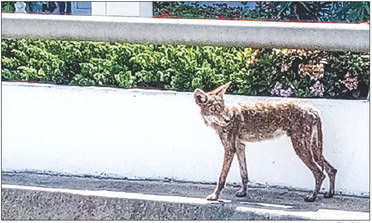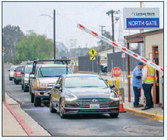Coyotes spotted in most LW Mutuals


WATCH YOUR PETS
by Ruth Osborn
rutho_news@lwsb.com
Coyote sightings are on the rise in almost every Mutual in Leisure World. There is a reason why: it’s whelping season.
In California, coyotes breed mainly during January, February and March. The gestation period is about 60-63 days. Young are born March through May, with litter sizes averaging 5-6 pups. Coyotes produce one litter per year.
So coyotes are on the prowl for food and water.
It used to be that coyotes could mostly be seen at dusk and dawn slinking along in the shadows.
But lately, they are everywhere, at all hours and in almost all Mutuals, according to residents posting on Facebook and Nextdoor.
Coyotes typically skulk away at the first sign of a human, but some LW residents are reporting more brazen behavior. They are posting pictures of coyotes making their way through carports, peering in patios and loping through greenbelts.
Coyotes typically winter in dens until spring, when they emerge to hunt. Their primary food is rodents, squirrels and rabbits, but they will eat almost anything, including fruit, grass and vegetables. They take advantage of whatever is available, including garbage, pet food and domestic animals.
Animal control experts recommend that residents follow these precautions to keep the coyotes away from neighborhoods:
•Close the lids of community garbage containers after trash is placed inside. This will eliminate a food source for the animal.
•Protect pets, and do not leave pet food or water in patio areas.
•Put away bird feeders at night to avoid attracting rodents and other coyote prey.
•Be aware of surroundings while walking dogs in the evening and early morning hours. Loud noises will scare off the animals, which are typically frightened of humans and run from conflict.
•Don’t leave doors or windows open, and make sure vents are screened so there is no access to apartments.
If food and water are removed, and people haze coyotes, the animals will move on to more hospitable locales. Hazing is coyote deterrent that uses scare tactics to reinstill fear of humans. Hazing techniques include:
•Yell and wave your arms while approaching a coyote.
•Use noisemakers such as whistles, air horns, bells or soda cans filled with pennies to scare the coyote.
•Throw sticks, small rocks, cans, tennis balls or rubber balls at the coyote.
•Use hoses, water guns or spray bottles.
Never approach a sick, injured or cornered coyote.
Animal control will only respond if the coyote is sick or injured or if it is threatening or attacking a person. There have been no reports of threatening coyote behavior in LW.
It is a violation of state law to feed wildlife because it alters their natural behaviors.
For more information, contact Seal Beach’s contracted provider, Long Beach Animal Care Services, at (562) 570-7387.



